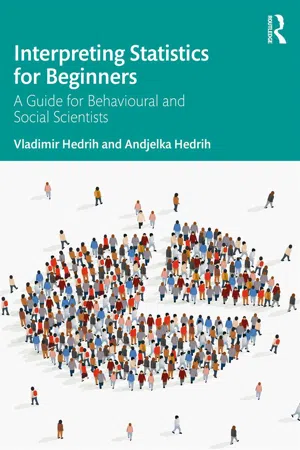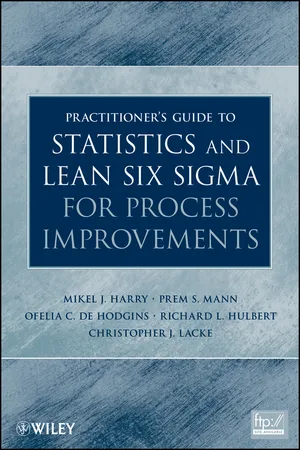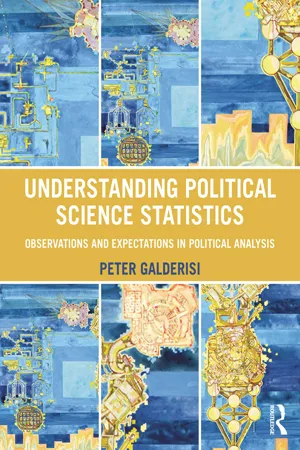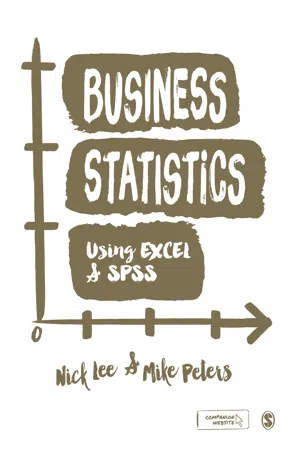Comparing Two Means Hypothesis Testing
Comparing two means hypothesis testing is a statistical method used to determine if there is a significant difference between the means of two independent groups. It involves formulating null and alternative hypotheses, calculating test statistics such as t-test or z-test, and making a decision based on the p-value. This method is commonly used in research and experimental studies to compare the effects of different treatments or interventions.
8 Key excerpts on "Comparing Two Means Hypothesis Testing"
- eBook - ePub
Statistics for the Behavioural Sciences
An Introduction to Frequentist and Bayesian Approaches
- Riccardo Russo(Author)
- 2020(Publication Date)
- Routledge(Publisher)
...8 Comparing a pair of means: The matched- and the independent-samples t -test (Frequentist approach) 8.1 Introduction In Chapter 7 we mainly described how to decide if a set of observations was drawn from a given population. We showed how to apply the t -test in assessing the probability that a set of observations, with their observed mean, was drawn from a population with a given mean. In that chapter we also showed how to use sample data to construct confidence intervals that have a given probability of containing the true population mean and we showed how to perform statistical power analysis on the one-sample t- test. In this chapter we will extend the application of the t -test to situations in which we intend to compare the means obtained from two sets of observations. The aim of this comparison is to decide if the two sets are sampled from the same population or not. If the outcome of the t -test gives a sufficiently small probability of the two sets of observations being drawn from the same population, then we declare that the two sets of observations are drawn from different populations (i.e., there is a significant difference between the means). Two different conditions in which the t -test is applied to compare a pair of means will be described: when the means are obtained from two sets of related observations; and when the two sets of observations are independent. We also explain how to construct confidence intervals for the difference of a pair of population means and to perform power analysis. We will also describe the conditions where the t -test may not be appropriate for comparing pairs of means. This occurs when some of the assumptions underlying the use of the t -test are violated. For these cases we indicate alternative ways to analyse the data. Given the strong similarity to the one-sample t -test, we first describe the application of the t -test to sets of related observations...
- eBook - ePub
Interpreting Statistics for Beginners
A Guide for Behavioural and Social Scientists
- Vladimir Hedrih, Andjelka Hedrih(Authors)
- 2022(Publication Date)
- Routledge(Publisher)
...In other words, they typically have higher power compared to tests created for independent samples. 7.2 Comparing two means – t test The t test is a parametric test created for determining whether two samples come from populations with the same value of the arithmetic mean. This is done by testing the null hypothesis that the difference between means of two populations is zero. This is based on the calculation of a standard error of the differences of the mean and then dividing the obtained difference between sample means with the standard error of difference between sample means. As with all standard errors, standard error of difference between means then depends on the variability of the samples on which they were calculated (i.e. their standard deviations/variances) and on sample size. The larger the sample and the smaller the variability of values of entities in both samples, the smaller the standard error of difference between means will be. The difference between means is than calculated and divided by this standard error of differences between means and the result obtained in this way is called the t statistic. The t statistic is than used to estimate the probability of obtaining the difference between means as was obtained between these two samples or larger when the difference between population means is 0 and this probability is the statistical significance of the t test. If the result of the t test is statistically significant i.e. if p is lower than the accepted threshold of statistical significance (most commonly.05), we can reject the null hypothesis and conclude that samples do not come from populations with the same mean on the examined variable. On the other hand, if the value of statistical significance is above the accepted threshold, we accept the null hypothesis and conclude that there is insufficient evidence that population means are not the same (i.e...
- eBook - ePub
Medical Statistics
A Guide to SPSS, Data Analysis and Critical Appraisal
- Belinda Barton, Jennifer Peat(Authors)
- 2014(Publication Date)
- BMJ Books(Publisher)
...Chapter 3 Comparing two independent samples Do not put faith in what statistics say until you have carefully considered what they do not say. WILLIAM W. WATT Objectives The objectives of this chapter are to explain how to: conduct an independent two-sample, parametric or non-parametric test assess for homogeneity of variances calculate and interpret effect sizes and 95% confidence intervals report the results in a table or a graph understand sample size requirements critically appraise the analysis of data from two independent groups in the literature 3.1 Comparing the means of two independent samples A two-sample t -test is a parametric test used to estimate whether the mean value of a normally distributed outcome variable is significantly different between two groups of participants. This test is also known as a Student's t -test or an independent samples t -test. Two-sample t -tests are classically used when the outcome is a continuous variable and when the explanatory variable is binary. For example, this test would be used to assess whether mean height is significantly different between a group of males and a group of females. A two-sample t -test is used to assess whether two mean values are similar enough to have come from the same population or whether their difference is large enough for the two groups to have come from different populations...
- eBook - ePub
- Hugh Coolican(Author)
- 2018(Publication Date)
- Routledge(Publisher)
...Chapter 17 Testing for differences between two samples This chapter introduces statistical tests for assessing the significance of differences between two samples and also introduces calculations of effect size and power. The related t test is used where data are in pairs, from repeated measures or matched pairs design. H 0 is that the mean of the population of difference means (means of differences between each pair of values in a sample) is zero. The t test for unrelated data (from independent samples) tests H 0 that the population of differences between two means has a mean of zero; that is, it assumes that the two populations from which the two samples are drawn have identical means. The single sample t test is used to test the null hypothesis that a single sample was drawn from a population with a certain mean; we usually wish to show that the sample mean would rarely be drawn from such a population and therefore that the sample is probably drawn from a population with a different mean. t tests are a type of parametric or distribution dependent test that depend on certain data assumptions for their results to be valid – homogeneity of variance, interval-level data and. a normally shaped sampling distribution. Ways to reduce skew are outlined, including transformation of data. These tests are considered robust and more power efficient than their non-parametric equivalents, which are also dealt with here – the Mann-Whitney U for unrelated data and the Wilcoxon Matched Pairs (T) for related data...
- Mikel J. Harry, Prem S. Mann, Ofelia C. De Hodgins, Richard L. Hulbert, Christopher J. Lacke(Authors)
- 2011(Publication Date)
- Wiley(Publisher)
...17 Estimation and Hypothesis Tests: Two Populations 17.1 OVERVIEW Chapters 14 and 16 discussed the estimation and hypothesis testing procedures for μ and p involving a single population. This chapter extends the discussion of estimation and hypothesis testing procedures to the difference between two population means and the difference between two population proportions, as well as nonparametric and/or distribution-free tests that can be used when certain underlying conditions are not fulfilled. For example, we may want to make a confidence interval for the difference between the mean prices of houses in California and New York. Or we may want to test the hypothesis that the mean price of houses in California is different from that in New York. As another example, we may want to make a confidence interval for the difference between the proportions of defective items in all items manufactured on each of two machines. Or we may want to test the hypothesis that the proportion of defective items in all items manufactured on machine 1 is different from the proportion of defective items manufactured on machine 2. Constructing confidence intervals and testing hypotheses about population parameters are referred to as making inferences. 17.2 INFERENCES ABOUT DIFFERENCES BETWEEN TWO POPULATION MEANS FOR INDEPENDENT SAMPLES Let μ 1 be the mean of the first population and μ 2 be the mean of the second population. Suppose that we want to make a confidence interval and test a hypothesis about the difference between these two population means, that is, μ 1– μ 2. Let be the mean of a sample taken from the first population and be the mean of a sample taken from the second population. Then, is the sample statistic that is used to make an interval estimate and to test a hypothesis about μ 1 – μ 2. This section discusses how to make confidence intervals and test hypotheses about μ 1 – μ 2 when the two samples are independent...
- eBook - ePub
Understanding Political Science Statistics
Observations and Expectations in Political Analysis
- Peter Galderisi(Author)
- 2015(Publication Date)
- Routledge(Publisher)
...C HAPTER 7 Hypothesis Testing and the Concept of Association Observations and Expectations about the Difference between Means 1 C ONTENTS Comparison of Two Means Special Comment on Significance Tests Appendix: Comparison of Two Variables, Same or Matched Groups Key Terms Questions and Exercises Learning Objectives: To continue our discussion of hypothesis testing To understand how to apply the central limit theorem and normal curves to the analysis of differences between means To understand and learn how to calculate the standard error of mean differences To understand the difference between groups that are sampled independently and those in which the sampling in the second group is dependent on the first Thus far, we have acquainted ourselves only with descriptive and inferential measures of univariate statistics. The mathematical logic behind our next set of presentations on bivariate statistics follows the concepts already discussed. Before moving to an analysis of the association between two variables, however, some further terms need to be reintroduced. 2 We generally are concerned with analyzing bivariate (and eventually multivariate) statistics because we are trying to determine some causal linkage between two (or more variables). Let’s review some of the terms used in Chapter 1. Perhaps we are trying to determine whether one’s gender affects one’s income in some expected way (with women earning less than men), or if race determines one’s chance of being selected for grand jury service (with minorities having a lower chance of selection than white Anglo-Americans), or if the type of voting system influences turnout (with proportional representation systems typically having higher turnout than single member districting systems). In the strictly bivariate case, we are trying to determine if differences in one variable (the causal agent or antecedent condition) affect the value of another (the outcome or consequence)...
- eBook - ePub
- Nick Lee, Mike Peters(Authors)
- 2015(Publication Date)
- SAGE Publications Ltd(Publisher)
...Often, we have a hypothesis about the population difference that we want to test. In order to explain this, let’s introduce the notation D 0 to denote the hypothesized difference between the two population means, μ 1 − μ 2. There are three different forms of hypothesis test about D 0 that we might be interested in, but it is by far most common that we hypothesize that D 0 = 0. If so, we are basically saying that our null hypothesis is that there is no difference between the means of the two populations, and rejecting H 0 allows us to draw the conclusion that there is some difference between μ 1 and μ 2. Of course, we could also hypothesize that there was some difference between the means in the two populations, so, for the sake of completeness, here are the three different types of hypothesis test we could use when considering the difference between two means: The steps that were given for conducting hypothesis tests in earlier chapters are just as applicable here, so there is little need to dwell on them. In fact, you should already know them. But just in case, let’s recap. First, choose a level of significance, then compute the test statistic and finally find the p -value of the test statistic to decide whether or not you should reject the null hypothesis. The test statistic in this present case is z, as you might have predicted, and the expression to calculate z is similar to the interval estimate expression given earlier, so there seems little need to explain the terms again: It would be simplest to demonstrate this with an extension of the retail example given above. In this case we might have some theory that leads us to expect a difference across the mean incomes for the two separate populations shopping at each branch...
- eBook - ePub
- Andrew F. Hayes(Author)
- 2020(Publication Date)
- Routledge(Publisher)
...Chapter NINE Testing a Hypothesis About a Single Mean DOI: 10.4324/9781410613707-9 In Chapter 8, I introduced hypothesis testing and illustrated how to apply the concepts when testing a hypothesis about a population proportion. Throughout the rest of this book, we discuss hypothesis testing at length, starting with this chapter. As you progress through this chapter and the rest of the book, you will notice variations in the specifics of hypothesis testing. However, all hypothesis tests described in this book are governed by the same principle of confirmation through falsification and the use of a p -value for deciding between two statistical hypotheses (the null and the alternative). The procedures in this chapter focus entirely on testing hypotheses that can be phrased statistically in terms of a single mean. The wide majority of research hypotheses tested by communication researchers focus on differences between groups or the relationship between two or more variables rather information about a single measure such as a mean computed in a single sample. However, because of its simplicity, we focus first on this simple test because it serves as a good introduction to the specifics of hypothesis testing, and mastering these procedures will give you valuable practice for the more advanced problems later in this book. Having said this, one of the tests in this chapter is used quite frequently in communication science in a special form. This test focuses on a comparison of means when the data come from a “matched pairs” research design. So there is some applied value in mastering the material in this chapter as well. 9.1 The One-Sample t test One topic that has inspired dozens of research studies in the field of communication is media censorship. Even in a democracy such as the United States where freedom of speech and the press is built into the laws of the country, some people nevertheless are supportive of censorship in at least some forms...







